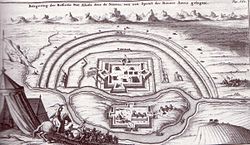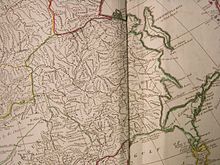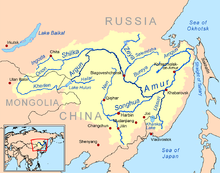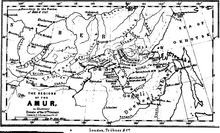- Russian–Manchu border conflicts
-
Russian-Manchu border conflicts 
Qing Empire forces storming the fort of AlbazinDate 1652 - 1689 Location Heilongjiang and Priamurye Result Draw
Treaty of NerchinskBelligerents Qing Empire
Joseon DynastyTsardom of Russia
CossacksCommanders and leaders Qing:
Haise (海色)
Xifu (希福)
Minggadari(明安达理)
Sarhuda
Joseon:
Byeon Geup
Shin RyuYerofey Khabarov
Onufriy Stepanov
Afanasy Pashkov
Alexei Tolbuzin
Afanasy BeitonStrength Qing:
15,000 men[1]
Joseon:
~400 men2,000 men[1] Casualties and losses Qing:
several hundreds (debated)
Joseon:
~40 men~800 men[2]  The region of the conflict depicted on a British map about a century after the events, when most of it became parts of the Chinese provinces of Qiqiha'er (Tcitcisar) and Jilin (Kirin). Nimguta (Ninguta) was the main early base of Manchu river fleets, which was later relocated to Kiring Ula (Jilin City). Saghalien R. and Tchikiri R. are the Amur and the Zeya. Saghalien, or Ula Hotum (Aigun) was the Manchus' forward base for the attacks on Albazin (which itself is not shown on this map); Aihom ruin(e)d, was Aigun's original site on the left bank of the Amur. Mergenkhotun (Nenjiang[disambiguation needed
The region of the conflict depicted on a British map about a century after the events, when most of it became parts of the Chinese provinces of Qiqiha'er (Tcitcisar) and Jilin (Kirin). Nimguta (Ninguta) was the main early base of Manchu river fleets, which was later relocated to Kiring Ula (Jilin City). Saghalien R. and Tchikiri R. are the Amur and the Zeya. Saghalien, or Ula Hotum (Aigun) was the Manchus' forward base for the attacks on Albazin (which itself is not shown on this map); Aihom ruin(e)d, was Aigun's original site on the left bank of the Amur. Mergenkhotun (Nenjiang[disambiguation needed
 ]) and Tcitcisar (Qiqiha'er) were the two other main Manchu centers in northern Manchuria. Houmar River is the "Komar" of Russian records. Nerczinsk is the site of the treaty negotiations.
]) and Tcitcisar (Qiqiha'er) were the two other main Manchu centers in northern Manchuria. Houmar River is the "Komar" of Russian records. Nerczinsk is the site of the treaty negotiations.The Russian–Manchu border conflicts (1652–1689) were a series of intermittent skirmishes between the Manchus and the Cossacks in which the Cossacks tried and failed to gain the land north of the Amur River. The hostilities culminated in the Manchu siege of the Cossack fort of Albazin (1686) and resulted in the Treaty of Nerchinsk, concluded between the Russia and the Qing Empire in 1689.
Contents
Background
This article concerns the southeast corner of Siberia south of the Stanovoy Mountains which was twice contested between Russia and China. Hydrologically, the Stanovoy Mountains separate the rivers that flow north into the Arctic from those that flow south into the Amur River. Ecologically, the area is the southeastern edge of the Siberian boreal forest with some areas good for agriculture. Socially and politically, from about 600 AD, it was the northern fringe of the Chinese-Korean-Manchu world. Various Chinese, Korean and Manchu-like states would claim sovereignty, build forts and collect tribute when they were strong enough. There were posts at Haishenwai(Vladivostok), Boli(Khabarovsk), Deren on the lower Amur and Tyr above Nikolaevsk-on-Amur. From 698 to 926 the Korean kingdom of Balhae ruled part of the area from an administrative center at Shuaibinbu (Ussuriisk). Tributary delegations came from Kuyedao (Sakhalin).
In 1643 russian adventurers spilled over the Stanovoys, but by 1689 they were driven back by the Manchus. In 1859/60 the area was annexed by Russia and quickly filled up with a Russian population.
The Qing Perspective
1639-1643 : Campaign led by Manchus against the indigenous rulers of the region
- December 1639-May 1640 : 1st battle - the natives and the Qing : Battle of Gualar (Russian: селение Гуалар) : between 2 regiments of Manchu and a detachment of 500 Solon-Daurs[3] led by the Solon-Evenk leader Bombogor (Chinese: 博木博果尔 or 博穆博果尔 pinyin :Bomboguoer) while the second native leader Bardači (Chinese: 巴尔达齐 or 巴尔达奇) kept neutral.
- September 1640 : 2nd battle - the natives and the Qing : Battle of Yaksa (Russian: Якса): between the natives (Solon, Daur, Oroqen) and the Manchus.
- May 1643 : 3rd battle. The native tribes submitted to the Qing Empire.
1643-1644 : Vasili Poyarkov
- Winter 1643 - Spring 1644 : a detachment of a Russian expedition led by the Cossack Vasili Poyarkov explored the stream of the Jingkiri river, present-day Zeya, and the Amur rivers.
1649-1653 : Yerofey Khabarov
- 1650-1651 : Occupation of the Daur's fort Albazin by Khabarov after subduing the Daurs led by Arbaši (Chinese: 阿尔巴西).
- March 24, 1652 : Battle of Achansk
1654-1658 : Onufriy Stepanov
- March–April 1655 : Siege of Komar
- 1655 : Russian Tsardom has established a "military governor of the Amur region".
- 1657 : 2nd Battle of Sharhody.
1654-1658 : The Manchu-Korean alliances expeditions against Russians
In the following operations significant Korean forces were included into Manchu-led troops. The campaigns became known in Korean historiography as Naseon Jeongbeol.
- January 1654 : the first time a Korean contingent arrived to join a Manchu army near Ninguta.
- July 1654 : Battle of Hutong (on lower reaches of the Sungari at the present-day Yilan) between a joint Korean-Manchu army of 1500 men led by Byeon Geup (Hangul: 변급 Hanja: 邊岌) against 400-500 Russians.
- 1658 : Sarhuda's Manchu fleet from Ninguta, including a large Korean contingent led by Shin Ryu sails down the Sungari into the Amur, and meets Onufriy Stepanov's smaller fleet from Albazin. In a naval battle in the Amur a few miles downstream from the mouth of the Sungari (July 10, 1658). The 11-ship Russian flotilla is destroyed (the survivors flee on just one ship), and Stepanov himself dies.[4]
1685-1687 : The Albazin/Yakesa Campaign
- May–July 1685 : The siege of Albazin
- July–October 1686 : The siege of New Albazin.
see also Outer Manchuria
Russian Point of View
This section retells the story from the Russian side (or rather from a Western reading of Russian sources). The sources, for the most part are Forsyth[5] Lincoln[6] and March.[7]
Russian expansion into Siberia began with the conquest of the Khanate of Sibir in 1582. By 1643 they reached the Pacific at Okhotsk. East of the Yenisei River there was little land fit for agriculture, except Dauria, the land between the Stanovoy Mountains and the Amur River which was nominally subject to the Manchus. The Manchus had recently reestablished their authority in the area and were just beginning their conquest of China (Qing Dynasty). The land was populated by some 9,000 Daurs on the Zeya River, 14,000 Duchers downstream and several thousand Tungus and Nivkhs toward the river mouth. The first Russians to hear of Dauria were probably Ivan Moskvitin and Maxim Perfilev about 1640.
1643-46:Poyarkov: In 1643 Vassili Poyarkov traveled from Yakutsk south to the Zeya River. He then sailed down the Amur River to its mouth and then north along the Okhotsk coast, returning to Yakutsk three years later.
1649-50: Khabarov: In 1649 Yerofei Khabarov found a better route to the upper Amur and quickly returned to Yakutsk where he recommended that a larger force be sent to conquer the region.
1650-53 Khabarov again: He returned the same year and built winter quarters at Albazin at the northernmost point on the river. Next summer he sailed down the Amur and built a fort at Achansk (Wuzhala (乌扎拉)) probably near present-day Khabarovsk. Again there was fighting and the natives called in their Manchu overlords. On 24 March 1652, Achansk was unsuccessfully attacked by a large Qing force [600 Manchu soldiers from Ninguta and about 1500 Daurs and Duchers led by the Manchu general known as Haise (海色),[8] or Izenei (Изеней or Исиней).[9] Haise was later executed for his poor performance.[10]]. As soon as the ice broke up Khabarov withdrew upriver[11] and built winter quarters at Kumarsk. In the spring of 1653 reinforcements arrived under Dmitry Zinoviev. The two quarreled, Khabarov was arrested and escorted to Moscow for investigation.
1653-58:Stepanov: Onufriy Stepanov was left in charge with about 400-500 men. They had little difficulty plundering the natives and defeating the local Qing troops. The Qing responded with two policies. First they ordered the local population to withdraw, thereby ending the grain production that had attracted the Russians in the first place. Second they appointed the experienced general Sarhuda (who himself was from the Nierbo village from the mouth of Sungari) as the garrison commander at Ninguta. In 1657 he built more than 40 ships at the village of Ula (modern Jilin).[citation needed]. In 1658 a large Qing fleet under Sarhuda caught up with Stepanov and killed him and about 220 Cossacks. A few escaped and became freebooters.
1658-65:No man's land: By 1658 the Chinese had wiped out the Russians below Nerchinsk and the deserted land became a haven for outlaws and renegade Cossacks. In 1660 a large band of Russians was destroyed. They had some difficulty pursuing the Cossacks since their own policy had removed most of the local food. In the 1670s the Chinese attempted to drive the Russians away from the Okhotsk coast, reaching as far north as the Maya River.
1665-1689:Albazin: In 1665 Nikifor Chernigovsky murdered[12] the voyvoda of Ilimsk and fled to the Amur and reoccupied the fort at Albazin, which became the center of an unofficial colony. In 1670 it was unsuccessfully attacked. In 1672 Albazin received the Czar's pardon and was officially recognized. From 1673 to 1683 Manchu forces were tied up suppressing a rebellion in the south. In 1682 or 1684 a voyvoda was appointed by Moscow. In 1685 the Manchus, now freed from their wars, invested the fort which surrendered on liberal terms. Most of the Russians withdrew to Nerchinsk, but a few joined the Manchus, becoming the Albazin Cossacks at Peking. The Chinese withdrew from the area, but the Russians, hearing of this, returned with 800 men under Aleksei Tolbuzin and reoccupied the fort. (their original purpose was merely to harvest the local grain, a rare commodity in this part of Siberia.) From June 1686, the fort was again besieged. Either (the siege was raised in December when it was learned that the two empires were engaged in peace negotiations[13]) or (the fort was captured after an 18 month siege and Tolbuzin killed[14]). At that time less than 100 defenders were left alive.
Treaties
In 1689, by the Treaty of Nerchinsk, the Russians abandoned the whole Amur country including Albazin. The frontier was established as the Argun River and the Stanovoy Mountains. In 1727 the Treaty of Kyakhta confirmed and clarified this border and regulated Russo-Chinese trade.
In 1858, almost two centuries after the fall of Albazin, by the Treaty of Aigun, Russia annexed the land between the Stanovoy Mountains and the Amur (commonly referred to in Russian as Priamurye, i.e. the "Lands along the Amur"). In 1860, with the Convention of Beijing, Russia annexed the Primorye (i.e. the "Martitme Region") down to Vladivostok, an area that had not been in contention in the 17th century. See Amur Annexation.
References and Bibliography
- ^ a b CJ. Peers, Late Imperial Chinese Armies 1520-1840, 33
- ^ China Marches West: The Qing Conquest of Central Eurasia By Peter C. Perdue Published by Harvard University Press, 2005
- ^ А.М.Пастухов (A.M. Pastukhov) К вопросу о характере укреплений поселков приамурских племен середины XVII века и значении нанайского термина «гасян» (Regarding the fortification techniques used in the settlements of the Amur Valley tribes in the mid-17th century, and the meaning of the Nanai word "гасян" (gasyan)) (Russian)
- ^ A.M. Pastukhov, "Корейская пехотная тактика самсу в XVII веке и проблема участия корейских войск в Амурских походах маньчжурской армии " (Korean infantry tactic samsu (三手) in the 17th century, and the issues related to the Korean troops' participation in the Manchus' Amur campaigns) (Russian)
- ^ Forsyth, James (1994). A History of the Peoples of Siberia: Russia's North Asian Colony 1581-1990. Cambridge University Press. ISBN 0521477719. http://books.google.com.au/books?id=nzhq85nPrdsC.
- ^ Lincoln, W. Bruce (2007 (earlier edition, 1994)). The Conquest of a Continent: Siberia and the Russians. Cornell University Press. ISBN 0801489229. http://books.google.com/books?id=a7JrTvgU4yMC.
- ^ G. Patrick March, Eastern Destiny: the Russians in Asia and the North Pacific, 1996
- ^ Gong, Shuduo; Liu, Delin (2007). 图说清. 知書房出版集團. p. 66. ISBN 986715164X. http://books.google.com.au/books?id=5XzTXqTwECcC. (Although this particular book seems to misspell 海色 as 海包 (Haibao))
- ^ Август 1652 г. Из отписки приказного человека Е.П. Хабарова якутскому воеводе Д.А. Францбекову о походе по р. Амуру. An excerpt from Khabarov's report to the Yakutsk Voivode D.A.Frantsbekov, August 1652.) (Russian)
- ^ Hummel, Arthur William (1970). Eminent Chinese of the Ch'ing period (1644-1912), vol. 2. Ch'eng Wen Publishing Co.. p. 632. http://books.google.com.au/books?id=Hs8LhXwRqPgC. "Haise was executed for this disgrace" "SARHUDA" article.
- ^ Оксана ГАЙНУТДИНОВА (Oksana Gainutdinova) Загадка Ачанского городка (The mystery of Fort Achansk)
- ^ Ravenstein, The Russians on the Amur, 1860(sic), Google Books
- ^ March, chapter 5
- ^ John J. Stephen, The Russian Far East, 1994,page 31
1. Page 133 -152 China Marches West: The Qing Conquest of Central Eurasia By Peter C. Perdue Published by Harvard University Press, 2005
Categories:- 17th-century conflicts
- History of Northeast Asia
- History of Manchuria
- History of Siberia
- Amur Oblast
- Wars involving Qing Dynasty
- Wars involving Russia
- Wars involving Joseon Dynasty
- Cossacks
- 17th century in Russia
- China–Russia relations
- Qing Dynasty History
Wikimedia Foundation. 2010.


